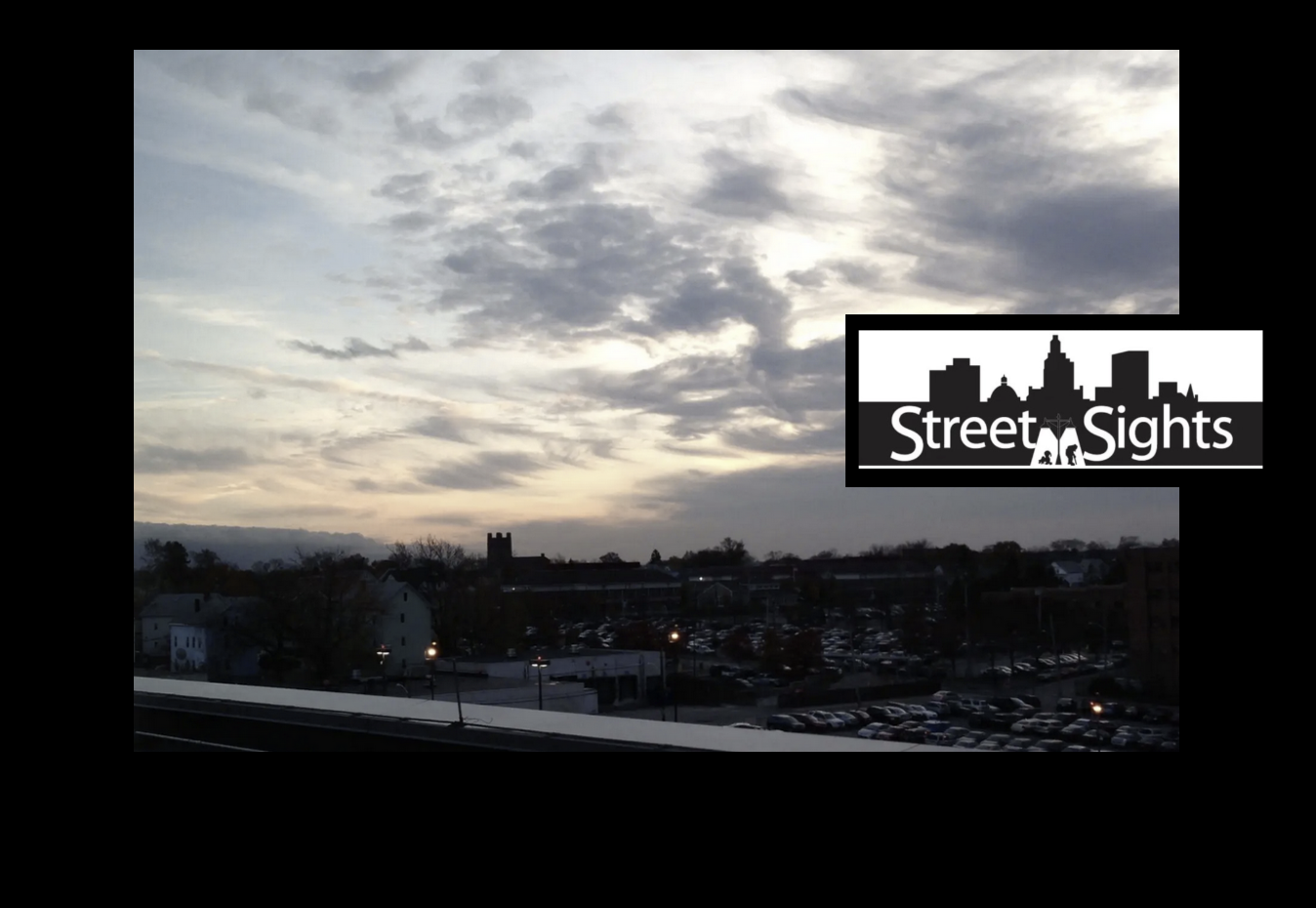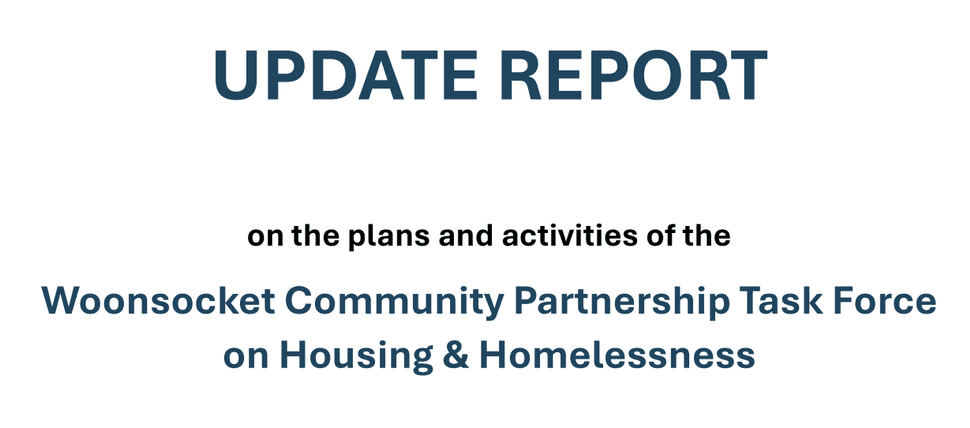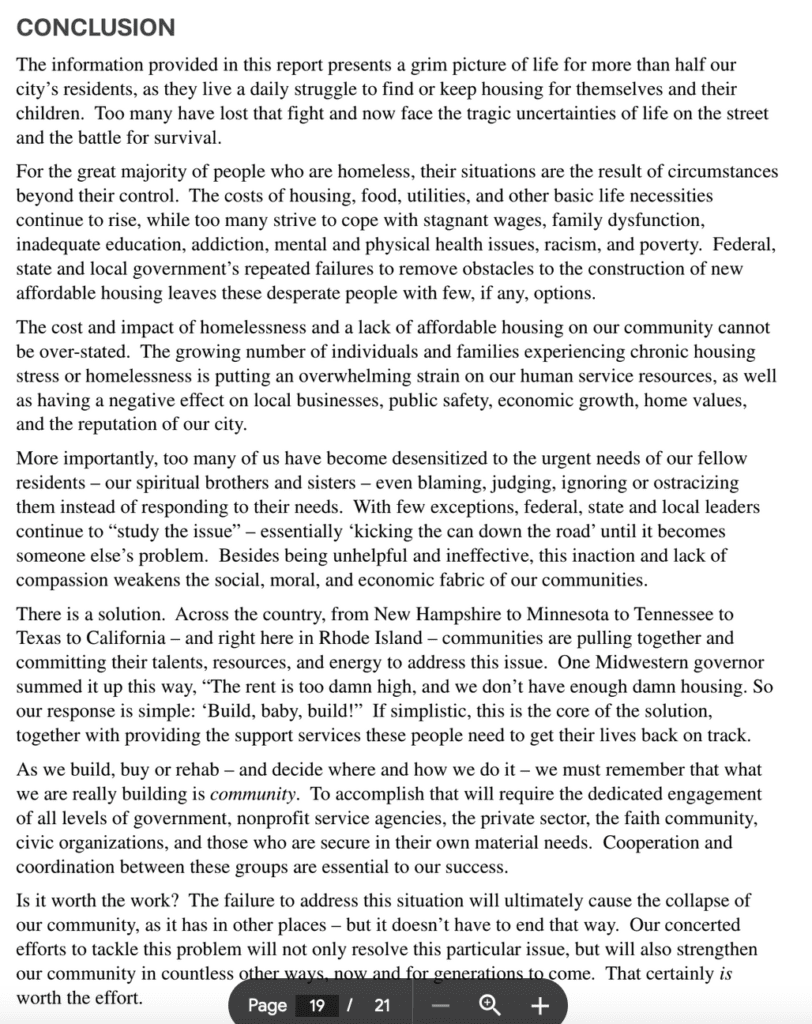Search Posts
Recent Posts
- Rhode Island Legislature Highlights Accomplishments for the 2025 Session June 25, 2025
- Sports in RI: Cody Tow, Volleyball Past, Present and Into His Future – John Cardullo June 25, 2025
- Need a Break? Time for Sour Grapes – Tim Jones June 25, 2025
- Rhode Island Weather Forecast for June 25, 2025 – Jack Donnelly June 25, 2025
- It is what it is: Commentary on 6.25.25 with Jen Brien June 25, 2025
Categories
Subscribe!
Thanks for subscribing! Please check your email for further instructions.

Homeless in RI: 40 days to winter, empty Pallet Shelters, “no” encampments, StreetSights
40 days until the 1st day of winter: December 21, 2024
An update on the programs, services, and status of homelessness in and around Rhode Island and elsewhere – including our monthly article from StreetSights, the publication by and for those experiencing homelessness:
Affordable Housing… For Whom?
by Antonietta Kies, Street Sights – special to RINewsToday
“We are not all in the same boat. We are in the same storm”. – Damian Barr
It is widely known that New England is an expensive region to live. In 2024, CNBC reported that of the ten most expensive states according to monthly cost, three are within New England, the United States’ smallest geographical region (Massachusetts, Connecticut, and New Hampshire). The average monthly cost of groceries per person was higher in Vermont than in any state except for Hawaii. Boston, MA ranked tenth on the list of most expensive cities in the U.S., with a median home sale price of $776,500 in 2024.
In Rhode Island, the median price was $460,000. But unique to Rhode Island was the fact that it ranked last of all states in per capita housing production as recently as 2021. This ranking has been falling since 2012. Rhode Island also falls behind Massachusetts in dedicated revenue sources invested in affordable housing. Fewer homes are being made, and more of the existing ones are out of reach. Where are people supposed to go?
The Rhode Island Public Expenditure Council (RIPEC) analyzed the recent state investments in affordable housing in October. It found that low housing production and low investments “have created a shortage of available housing across the state”. In order to address this, different funding sources have been utilized for positive change. Starting in 2022, most of $332.3 million in federal State Fiscal Recovery Funds (SFRF) were directed towards affordable housing initiatives. In 2024, administered by the Rhode Island Housing agency, the Neighborhood Opportunities Program (NOP) provided subsidies to landlords renting to extremely low income families in order to keep their rents affordable.
Affordability is Relative
The word “affordable” is used in casual discussions of rent and mortgage. But what does this subjective word mean? One definition might be “in reach of the median income household”. Others might be “cheaper than other houses within the same neighborhood”, or “costing less than 30% of pre-tax income per month”. Only the last of these definitions really has meaning, because the truth is: affordability is relative. If homes in a neighborhood are deemed “affordable” relative to the median income for that city, how does this fact help any one household that earns below the median income? And furthermore, are the most inexpensive homes or units guaranteed to be rented to or owned by those who need them most? Of course not!
Affordable… to whom?
“Household income” is not a one-size-fits-all term, either. The median household income in Rhode Island was $81,860 in 2023, but how much information does even this number provide without the knowledge of the number of people in the household? For example, according to the 30% rule, a single person earning $81,860 could rent a one-bedroom apartment up to $2,047. The average (not median) one bedroom apartment rent across Rhode Island is $1,758. For a three-bedroom rental, this price is $2,396. So how could a family of four with that median household income get by – and with the proportionally higher cost of groceries, health care, and utilities, nonetheless? And that’s only the median household income, to say nothing of the lower echelons. In fact, HousingWorks RI found that this year, “for the first time in Rhode Island’s history, there are zero municipalities in which a household with an income under $100,000 a year could actually buy.”
Again, we ask: Where are people supposed to go?
According to the Rhode Island Current, the number of homeless increased 65% from 2020-2023. This begs the question of how a person is expected to get out of the cycle of homelessness when homelessness makes it harder for people to get (or keep) jobs, which makes it harder for them to even have a chance at affording housing, et cetera.
From the website of Crossroads RI, the state’s largest homelessness service provider: “The vast majority of Rhode Island’s homeless population are the working poor.” While this fact does not presume knowing the story of any one person experiencing homelessness, what it does remind us of is the proximity of homelessness to millions of people for whom additional factors like disability or severe mental illness don’t even play a part.
We have said it before, and we’ll say it again: “You might not struggle with mental illness before homelessness, but after, you probably will.” We don’t think that a solution for involuntary homelessness can be reached without compassion. Far too often, our policymakers tout the numbers of dollars spent on affordable housing without explaining exactly how the money was used, and without focusing on the people who are still out there with no place to sleep – tonight.
As of this writing, there is no plan for those who are living outside, no word from the city or the state as to where the people are going to go – tonight. We can talk about affordable housing forever, but affordable housing does not meet the needs of those who are living outside in deplorable conditions.
HOMELESSNESS UPDATE:
Interagency Council on Homelessness – Advocates, led by Vin Marzullo, have reminded the state that the Interagency Council on Homelessness is required by state rules and regulations, yet it has been absent for years. A letter was sent to Rep. Patricia Serpa and meetings have been held, with little progress. However, there has been agreement that the Council should be established. Here is its regulatory description:
RIGL 40-17-5. Advisory council established.
(a)There is hereby created a permanent advisory council to the interagency council on homelessness containing representation ofadvocates; service providers; members of the veteran community, including housing providers and a current or former homeless veteran; current and/or former members of the homeless community; as well as representatives specifically affiliated with youth homelessness. All new members shall be chosen and approved by majority vote of the members present at an official meeting. At no time shall there be less than three (3) representatives of the homeless community, current or former. The chair shall be elected by a majority of the members.
(b)The purpose of the council is to inform the interagency council on homelessness on the current status and issues facing the homeless throughout Rhode Island.
_
Marzullo reports a meeting was held with RI Housing and advocates to discuss various topics, including:
“¢ Governor’s Declaration: a state of emergency on unsheltered homelessness
“¢Immediate reactivation ofInteragency Council on Homelessness
“¢Scheduled dateforresidents to be placed atECHO Village – services to be provided, resident classification/selection
“¢Detailed schedule of construction of shelter beds, transitional and permanent support housing? What is the capacity building strategy?
“¢Identify pre-employment activities, life skills training and occupational training that would be targeted/coordinated for individuals in transition. No current arrangements exist at Mathewson Street Church.Is there a support component to foster self-sufficiency?
“¢Has RI Dept. of Housing begun to identify/inventory abandoned buildings that could be repurposed for shelter beds and/or permanent supportive housing?
“¢ Exploring new public housing models with local housing authorities that would incorporate participation of the RI Build Trades (interest recently expressed) and apprenticeship opportunities for previously unhoused individuals? Providence is open to modeling or piloting via the Providence Housing Authority.
“¢ Soliciting input and engagement from the RI League of Cities and Towns?
“¢Data Disconnect — review HMIS and CES data analytics and performance measures. Status?
___
STATEWIDE
DCYF says it wants out of the business of locating hotel rooms and placing homeless families – 120 cases this year provided for, costing approx. $7.5M. As departments respond to necessary budget cuts, DCYF identified this program to cut.
Rhode Island Coalition to End Homelessness will hold its annual State of Homelessness event on Tuesday, November 19th, 2024 from 5:30 – 7 pm at CIC Providence, 225 Dyer Street, 2nd Floor. It is open to the public, and includes light refreshments provided after a short speaking program. Donations are encouraged, but not required.
PAWTUCKET
Memorial Hospital – Mayor Grebien has ordered the hospital to be boarded up until it is sold. It has become a graffiti and safety nuisance with broken windows, etc. The city will be paid back for its cost by putting a lien on the hospital, for when it is sold. Grebien says the hospital”s intended use is for its original intent – affordable housing, targeted to veterans.
PROVIDENCE
Pallet Shelters – Everyone wants to know what is happening with the “Echo Village” Pallet Shelter development in the Smith Hill area. Apparently there is a problem with certification by the fire code enforcers and fireproof paint has been brought out to assist, but a full suppression system is being mentioned. In a recent question made by advocate Steve Ahlquist, to Senator DiPalma, the Senator inquired if the shelters were “open yet” – showing a lack of priority and knowledge at the State House level. Rhode Island’s fire codes have long been a difficulty for many entertainment and residential facilities and they hail back to the Station Fire days. The company – Pallet Shelters – has said it has never had this problem in any other state. Notably, there have been fires in Pallet Shelter villages. The shelters in Providence are also built very close together.
Mathewson Street Church held a candlelight remembrance of people who died in 2023 who were experiencing homelessness. 54 names were read aloud. A second meeting has been held with Mayor Smiley and advocates. The Mayor reiterated his zero tolerance policy for encampments on state/city property. Advocates pressured if there is nowhere to place people, then how can they enforce that policy, with the Mayor saying the advocacy groups need to do their job, and the city does their job. Vacant buildings were suggested for use, but the Mayor said many of them are in uninhabitable code conditions and there are fewer than most people think. Police conduct in taking down the encampments was discussed and the Mayor said they can and will do better. An advocate asked if some sites – particularly those privately owned – could be “rented” for encampments, but Smiley was strong on the zero tolerance for outdoor encampments – “I would call a sanctioned encampment with trash receptacles and porta-potties and such is not something that I support for the City of Providence” Smiley noted their project-based voucher initiative where the voucher would stay with the housing unit and not the person so discrimination could be kept at a minimum and owners would already want to accept the vouchered tenants.
Huntington Avenue, Prov/Cranston line – One person died in an encampment area
CRANSTON
A 46 year old homeless man was found dead near the Cranston Bike Path. He had been, most recently, incarcerated at the ACI.
WEST WARWICK
Report to Town Council of encampment clearing: 2 people housed. 2 in detox. 1 incarcerated. Population decreased by 5. Several camps in the town are much cleaner. DPW had put dumpsters in the area. 6 encampments were vacated, and the area will be cleaned up. 2 new ones have developed. Town going out every other week. Next time they will go out earlier in the morning to be able to find people who are not “at work” – Narcan is given out. Town has considered forming a Task Force on Homelessness. Town reviewed a proposal from 2021on homelessness, affordable housing units, etc. Emergency Shelter setup was discussed. The Council said it would continue to monitor the situation, though passing a “no encampment” ordinance was of interest to some. Many mentioned that there are already laws on the books that would apply having to do with camping, trespassing, etc, and they should/could be enforced. The state is asking West Warwick to account for the $4M for housing allocated last year and that not every city and town can be responsible for housing the unhoused.
WOONSOCKET
Woonsocket released a 20+ page report on homelessness – see the full report, here:

Here are the conclusions:

As we go to print, the Dignity Bus in Woonsocket is not yet open for the season, though it is expected to open before December.
MASSACHUSETTS
NEW BEDFORD
If the city can add 50 more shelter beds and 90 more units of supportive housing, as laid out in a new review of its homeless services, New Bedford’s unsheltered homeless population could be reduced toas few as 15 people.
ELSEWHERE
NORTH CAROLINA
A homeless encampment in Asheville, NC, said to be “washed away” – could have over 100 people who have not been found, nor counted in death numbers from the floods. The camp was behind a Home Depot and had been there for years.
CALIFORNIA
Statewide policy to address the over 123,000 people who experienced unsheltered homelessness, living in tents, trailers, and vehicles across the state. State is looking at unused state land for homeless shelters and encourages all communities to adopt policies to clear encampment areas and provide adequate alternatives.
